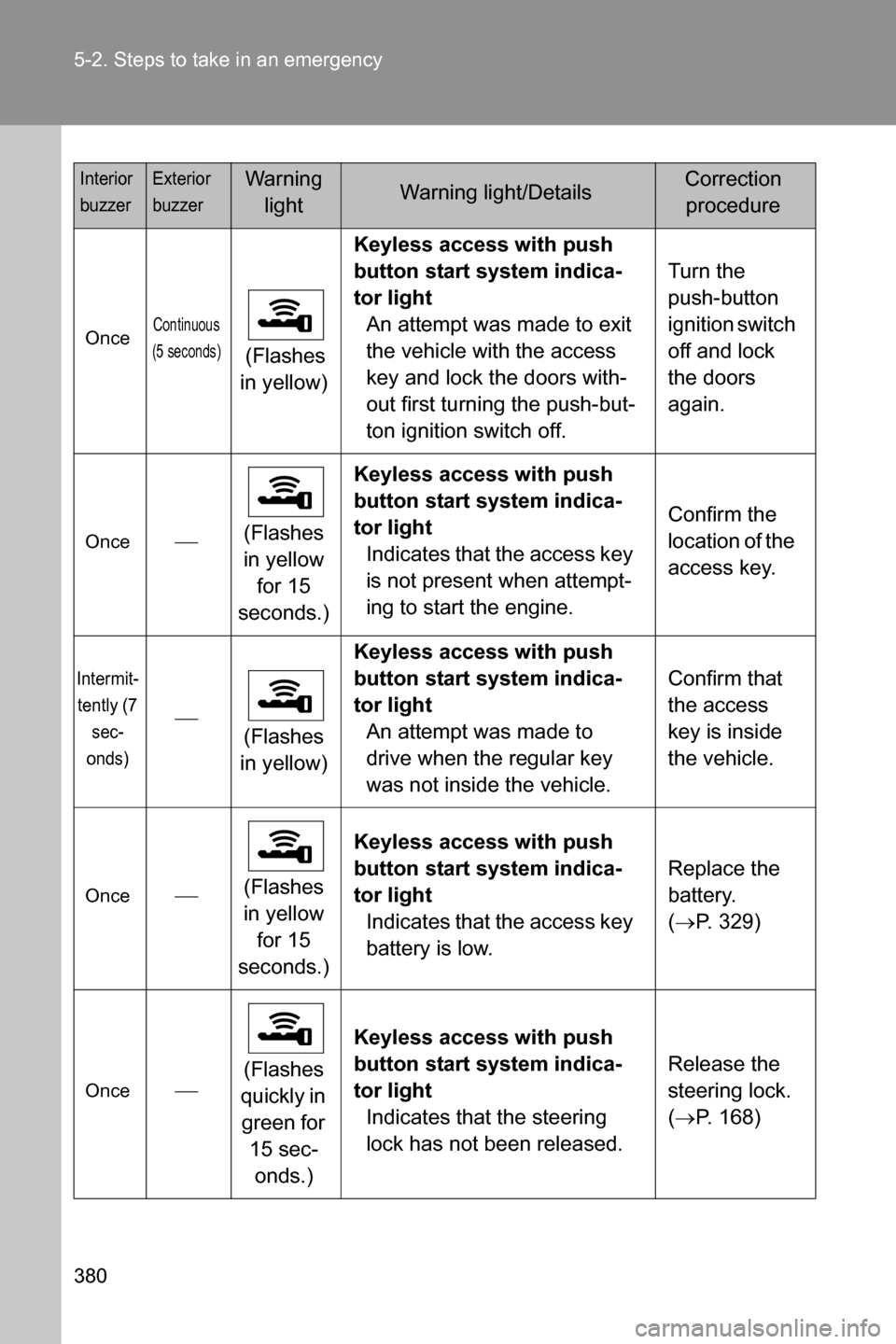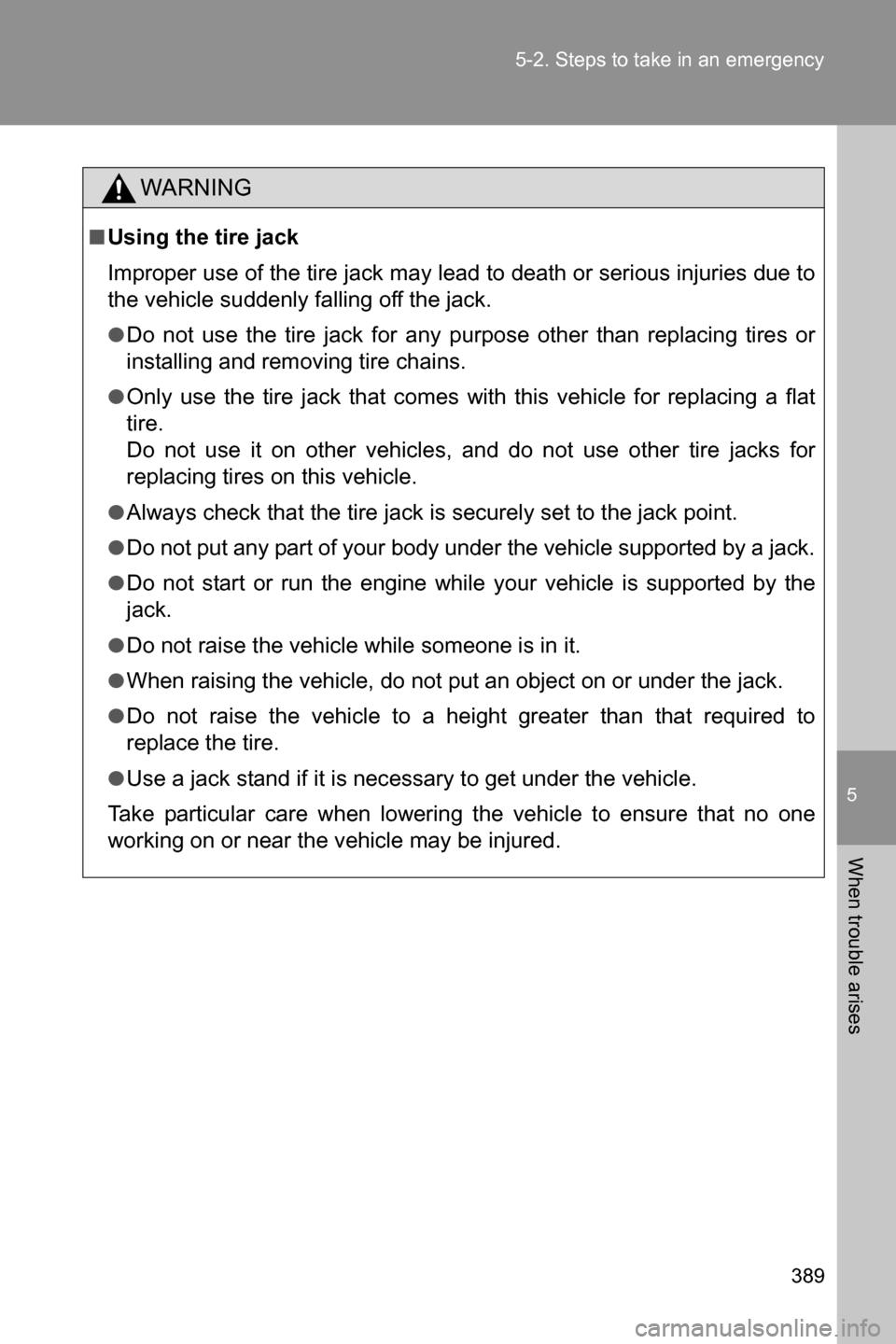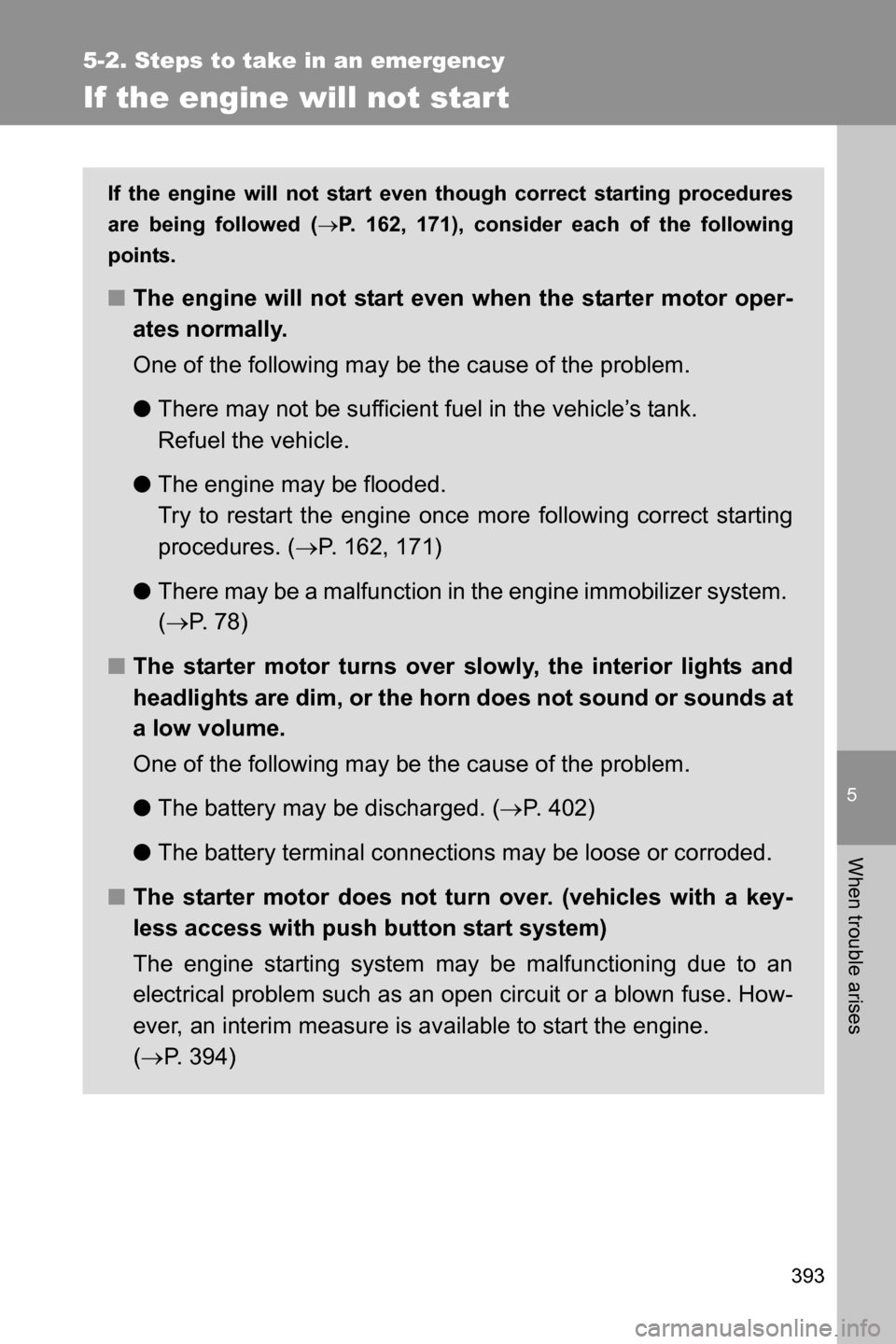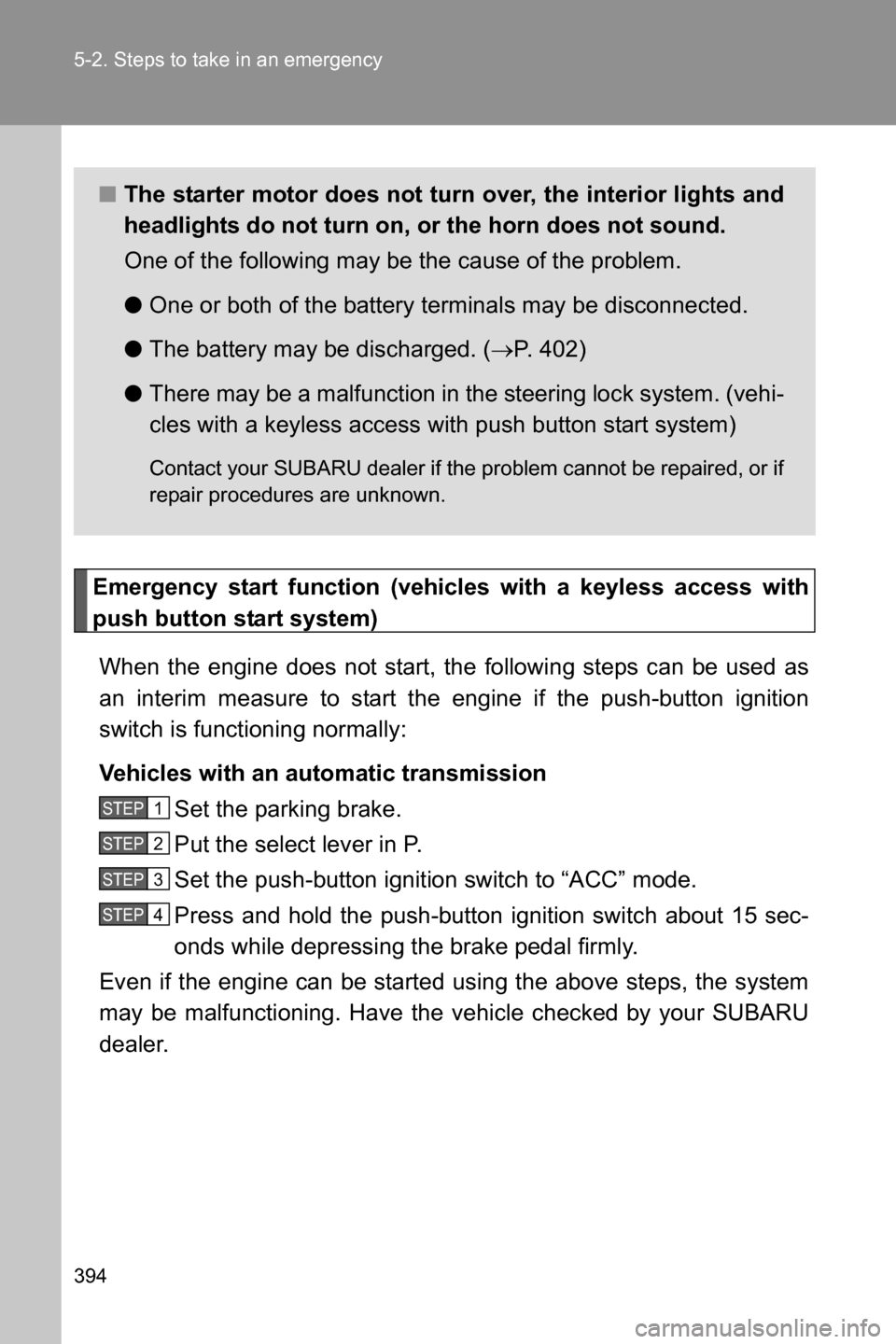Page 381 of 490

380 5-2. Steps to take in an emergency
OnceContinuous
(5 seconds)
(Flashes
in yellow)Keyless access with push
button start system indica-
tor light
An attempt was made to exit
the vehicle with the access
key and lock the doors with-
out first turning the push-but-
ton ignition switch off.Turn the
push-button
ignition switch
off and lock
the doors
again.
Once�(Flashes
in yellow
for 15
seconds.)Keyless access with push
button start system indica-
tor light
Indicates that the access key
is not present when attempt-
ing to start the engine.Confirm the
location of the
access key.
Intermit-
tently (7
sec-
onds)
�
(Flashes
in yellow)Keyless access with push
button start system indica-
tor light
An attempt was made to
drive when the regular key
was not inside the vehicle.Confirm that
the access
key is inside
the vehicle.
Once�(Flashes
in yellow
for 15
seconds.)Keyless access with push
button start system indica-
tor light
Indicates that the access key
battery is low.Replace the
battery.
(�oP. 329)
Once�(Flashes
quickly in
green for
15 sec-
onds.)Keyless access with push
button start system indica-
tor light
Indicates that the steering
lock has not been released.Release the
steering lock.
(�oP. 168)
Interior
buzzerExterior
buzzerWarning
lightWarning light/DetailsCorrection
procedure
Page 383 of 490
382
5-2. Steps to take in an emergency
If you have a flat tire
Your vehicle is equipped with a spare tire. The flat tire can be
replaced with the spare tire.
■Before jacking up the vehicle
●Stop the vehicle on a hard, flat surface.
●Set the parking brake.
●Shift the select lever to P (vehicles with an automatic trans-
mission) or shift lever to R (vehicles with a manual transmis-
sion).
●Stop the engine.
●Turn on the hazard warning flashers.
■Location of the spare tire, jack and tools
JackJack handle
Spare tire Towing eyelet
ScrewdriverWheel nut
wrench
Page 390 of 490

5
When trouble arises
389 5-2. Steps to take in an emergency
WARNING
■Using the tire jack
Improper use of the tire jack may lead to death or serious injuries due to
the vehicle suddenly falling off the jack.
●Do not use the tire jack for any purpose other than replacing tires or
installing and removing tire chains.
●Only use the tire jack that comes with this vehicle for replacing a flat
tire.
Do not use it on other vehicles, and do not use other tire jacks for
replacing tires on this vehicle.
●Always check that the tire jack is securely set to the jack point.
●Do not put any part of your body under the vehicle supported by a jack.
●Do not start or run the engine while your vehicle is supported by the
jack.
●Do not raise the vehicle while someone is in it.
●When raising the vehicle, do not put an object on or under the jack.
●Do not raise the vehicle to a height greater than that required to
replace the tire.
●Use a jack stand if it is necessary to get under the vehicle.
Take particular care when lowering the vehicle to ensure that no one
working on or near the vehicle may be injured.
Page 392 of 490

5
When trouble arises
391 5-2. Steps to take in an emergency
WARNING
■When using the compact spare tire
●Remember that your compact spare tire is specifically designed for
use with your vehicle. Do not use your compact spare tire on another
vehicle.
●Do not use two compact spare tires simultaneously.
●Replace the compact spare tire with a standard tire as soon as possi-
ble.
●Avoid sudden acceleration, abrupt steering, sudden braking and shift-
ing operations that cause sudden engine braking.
●Install the compact spare tire on a front wheel.
■When storing the compact spare tire
Be careful not to catch fingers or other body parts between the compact
spare tire and the body of the vehicle.
■Speed limit when using the compact spare tire
Do not drive at speeds in excess of 50 mph (80 km/h) when a compact
spare tire is installed on the vehicle.
The compact spare tire is not designed for driving at high speeds. Failing
to observe this precaution may lead to an accident causing death or seri-
ous injury.
■When the spare tire is attached
The vehicle speed may not be correctly detected, and the following sys-
tems may not operate correctly:
●ABS & brake assist
●Vehicle stability control (VSC)
●TRAC
●Electric power steering
●Navigation system (if equipped)
●Cruise control
●LSD (if equipped)
Page 394 of 490

5
When trouble arises
393
5-2. Steps to take in an emergency
If the engine will not start
If the engine will not start even though correct starting procedures
are being followed (�oP. 162, 171), consider each of the following
points.
■The engine will not start even when the starter motor oper-
ates normally.
One of the following may be the cause of the problem.
●There may not be sufficient fuel in the vehicle’s tank.
Refuel the vehicle.
●The engine may be flooded.
Try to restart the engine once more following correct starting
procedures. (�oP. 162, 171)
●There may be a malfunction in the engine immobilizer system.
(�oP. 78)
■The starter motor turns over slowly, the interior lights and
headlights are dim, or the horn does not sound or sounds at
a low volume.
One of the following may be the cause of the problem.
●The battery may be discharged. (�oP. 4 0 2 )
●The battery terminal connections may be loose or corroded.
■The starter motor does not turn over. (vehicles with a key-
less access with push button start system)
The engine starting system may be malfunctioning due to an
electrical problem such as an open circuit or a blown fuse. How-
ever, an interim measure is available to start the engine.
(�oP. 394)
Page 395 of 490

394 5-2. Steps to take in an emergency
Emergency start function (vehicles with a keyless access with
push button start system)
When the engine does not start, the following steps can be used as
an interim measure to start the engine if the push-button ignition
switch is functioning normally:
Vehicles with an automatic transmission
Set the parking brake.
Put the select lever in P.
Set the push-button ignition switch to “ACC” mode.
Press and hold the push-button ignition switch about 15 sec-
onds while depressing the brake pedal firmly.
Even if the engine can be started using the above steps, the system
may be malfunctioning. Have the vehicle checked by your SUBARU
dealer.
■The starter motor does not turn over, the interior lights and
headlights do not turn on, or the horn does not sound.
One of the following may be the cause of the problem.
●One or both of the battery terminals may be disconnected.
●The battery may be discharged. (�oP. 402)
●There may be a malfunction in the steering lock system. (vehi-
cles with a keyless access with push button start system)
Contact your SUBARU dealer if the problem cannot be repaired, or if
repair procedures are unknown.
STEP 1
STEP 2
STEP 3
STEP 4
Page 396 of 490
5
When trouble arises
395 5-2. Steps to take in an emergency
Vehicles with a manual transmission
Set the parking brake.
Put the shift lever in neutral.
Turn the push-button ignition switch to “ACC” mode.
Push and hold the push-button ignition switch for about 15
seconds while depressing the brake pedal and clutch pedal
firmly.
Even if the engine can be started using the above steps, the system
may be malfunctioning. Have the vehicle checked by your SUBARU
dealer.
STEP 1
STEP2
STEP 3
STEP 4
Page 397 of 490
396
5-2. Steps to take in an emergency
If the select lever cannot be shifted from P (vehicles with an automatic transmission)
If the select lever cannot be shifted with your foot on the brake, there
may be a problem with the shift lock system (a system to prevent
accidental operation of the select lever). Have the vehicle inspected
by your SUBARU dealer immediately.
The following steps may be used as an emergency measure to
ensure that the select lever can be shifted.
Set the parking brake.
Vehicles without a keyless access with push button start
system: Turn the engine switch to the “ACC” position.
Vehicles with a keyless access with push button start sys-
tem: Turn the push-button ignition switch to “ACC” mode.
Depress the brake pedal.
Pry the cover up with a flat-
head screwdriver or equiva-
lent.
Press the shift lock release
button.
The select lever can be shifted
while the button is pressed.
STEP 1
STEP 2
STEP 3
STEP 4
STEP 5